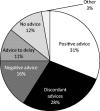Exploring reasons for non-vaccination against human papillomavirus in Italy
- PMID: 25410754
- PMCID: PMC4233085
- DOI: 10.1186/s12879-014-0545-9
Exploring reasons for non-vaccination against human papillomavirus in Italy
Abstract
Background: In Italy, free-of-charge HPV vaccination is offered to 11-year-old girls since 2007. The National Immunization Plan established the target coverage at a minimum of 70%; it should increase to 95% within 3-year time frame. In 2012, four year after the introduction of HPV vaccination, coverage was stable at 69%. We conducted a national cross-sectional study to explore barriers to vaccination in Italy.
Methods: Vaccination services selected, through the immunization registries, a sample of unvaccinated girls born in 1997 or 1998 and posted to their families a 23-items questionnaire inquiring barriers to vaccination, HPV knowledge, source of information on HPV, perception of risk of contracting HPV, advice from consulted health professionals on HPV vaccination.
Results: We analysed 1,738 questionnaires. Main barriers were fear of adverse events (reported by 80% of families), lack of trust in a new vaccine (76%), discordant information received by health professionals (65%) and scarce information on HPV vaccination (54%). Overall, 54% of families replied correctly to more than half of 10 questions exploring knowledge on HPV vaccination. Families with a high knowledge score were more likely to live in Northern and Central Italy, be Italian, have a high educational level, include a mother who attended cervical screening regularly and consult more information sources. Although paediatricians/general practitioners and gynaecologists were considered the most trusted source of information by 79% and 61% of respondents, they were consulted only by 49% and 31%. Among parents who discussed vaccination with a physician, 28% received discordant advices and 31% received the recommendation of accepting vaccination.
Conclusions: Fear of adverse events, discordance of information and advices from physicians, and scarce information were the more commonly reported barriers to HPV vaccination. Health professionals played a key role as information providers, thus they must be better trained to provide clear notions. Training needs to include the development of communication skills; transparent discussion about the pros and cons of vaccination may reduce fear of adverse events and increase trust in vaccination. The creation of a public health network around vaccination would allow sharing information and attitudes on vaccinations, so that homogeneous messages could reach the target population.
Figures


References
-
- World Health Organization position paper: Human papillomavirus vaccines. Weekly epidemiological record. 2009, 15(84):117-132. Available at: Accessed 10 March 2014., [http://www.who.int/wer/2009/wer8415.pdf]
-
- European Centre for Disease Prevention and Control: Vaccine schedule. Available at: Accessed 10 March 2014., [http://vaccine-schedule.ecdc.europa.eu/Pages/Scheduler.aspx]
-
- European Centre for Disease Prevention and Control: Introduction of HPV vaccines in EU countries - an update. Stockholm: ECDC; 2012. Available at: Accessed 10 March 2014., [http://ecdc.europa.eu/en/publications/publications/20120905_gui_hpv_vacc...]
-
- Presidency of the Council: State-Regions Agreement“Strategies for HPV vaccination active offer in Italy”; 2007. [in Italian] Available at: Accessed 10 March 2014., [http://www.statoregioni.it/Documenti/DOC_016696_264%20csr.pdf]
-
- Presidency of the Council: State-Regions Agreement“National Immunization Plan 2012-2014(Piano Nazionale Prevenzione Vaccinale, PNPV)".[in Italian] Available at: Accessed 10 March 2014., [http://www.statoregioni.it/Documenti/DOC_035260_54%20csr%20punto%204.pdf]
Publication types
MeSH terms
Substances
LinkOut - more resources
Full Text Sources
Other Literature Sources
Medical
Miscellaneous

